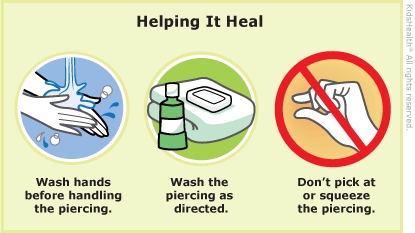A piercing can become infected when germs get into broken skin. Signs of infection include pus, bleeding, pain, redness, or swelling. Sometimes pus collects under the skin and forms a lump called an abscess. Infected piercings are common and usually heal well with proper care at home.

Follow your health care provider's instructions for:
- Whether you should remove the piercing.
- If your child should take any antibiotics or use any ointments.
- How to clean the infected piercing. In general:
- For skin piercings, clean the area at least once a day with soap and water. Blot dry with a clean towel.
- For tongue, cheek, or lip piercings, your child should use an antibacterial, alcohol-free mouthwash after every meal and before bed.
Other reminders:
- Always wash hands before cleaning or handling the piercing.
- For pain and swelling, hold a warm compress (a clean, wet, warm washcloth) to the piercing for a few minutes.
- Remind your child to not to pull on or play with the piercing.

Can piercing infections be prevented? It helps to:
- Get piercings from a licensed practitioner who:
- Washes their hands before each piercing
- Wears disposable gloves
- Uses single-use needles and sterilized instruments
- Uses hypoallergenic, nickel-free jewelry
- Clean piercings as directed.
- Avoid swimming until the piercing is healed.
- Avoid pulling on or playing with the piercing.
- Be sure any earring, stud, or back is loose enough not to cause irritation.



